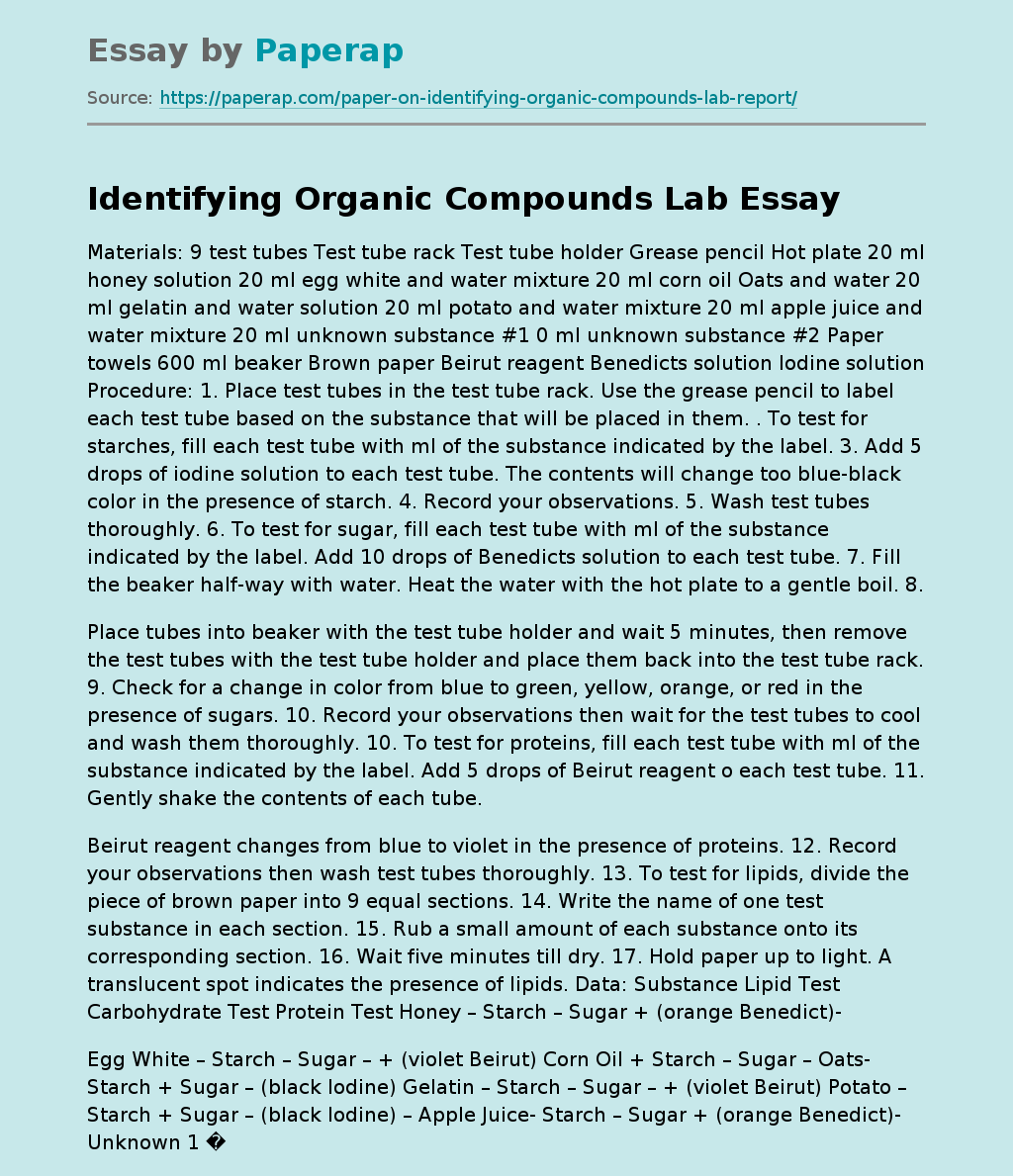Identifying Organic Compounds Lab
Materials: 9 test tubes Test tube rack Test tube holder Grease pencil Hot plate 20 ml honey solution 20 ml egg white and water mixture 20 ml corn oil Oats and water 20 ml gelatin and water solution 20 ml potato and water mixture 20 ml apple juice and water mixture 20 ml unknown substance 0 ml unknown substance Paper towels 600 ml beaker Brown paper Beirut reagent Benedicts solution Iodine solution Procedure: Place test tubes in the test tube rack. Use the grease pencil to label each test tube based on the substance that will be placed in them.
. To test for starches, fill each test tube with ml of the substance indicated by the label.
Add 5 drops of iodine solution to each test tube.
The contents will change too blue-black color in the presence of starch. Record your observations. Wash test tubes thoroughly.
To test for sugar, fill each test tube with ml of the substance indicated by the label. Add 10 drops of Benedicts solution to each test tube. Fill the beaker half-way with water. Heat the water with the hot plate to a gentle boil. Place tubes into beaker with the test tube holder and wait 5 minutes, then remove the test tubes with the test tube holder and place them back into the test tube rack. Check for a change in color from blue to green, yellow, orange, or red in the presence of sugars. 10. Record your observations then wait for the test tubes to cool and wash them thoroughly. To test for proteins, fill each test tube with ml of the substance indicated by the label. Add 5 drops of Beirut reagent o each test tube. 11. Gently shake the contents of each tube.
Beirut reagent changes from blue to violet in the presence of proteins. Record your observations then wash test tubes thoroughly. To test for lipids, divide the piece of brown paper into 9 equal sections. Write the name of one test substance in each section. Rub a small amount of each substance onto its corresponding section. 16. Wait five minutes till dry. Hold paper up to light. A translucent spot indicates the presence of lipids. Data: Substance Lipid
So, not a single substance didn’t test positive for at least 1 organic compound. All the indicators used in this experiment change color when in the presence of a compound; therefore, they chemically react with the compound. No errors were made during this experiment because all directions were followed carefully and the indicators were used and read properly. Conclusion: My hypothesis was that honey will contain sugars, egg white contains proteins, corn oil contains lipids, oats contains starches and proteins, gelatin contains sugars and proteins, potatoes contain starch, and apple juice notations lipids and sugars.
My hypothesis was mostly correct. Oats do not contain protein, gelatin does not contain sugars, and apple juice does not contain lipids. Since apple juice is sweet, I guessed that it would contain fats as well as sugars; however, it does not contain lipids. I thought that gelatin would contain sugar because it too is sweet, but it only contains proteins. Oats do not contain protein as I had hypothesized, and I guessed that it did because I had a gut feeling. I couldn’t support that hypothesis because I had little experience with oats. That is why my hypothesis is mostly correct.
Identifying Organic Compounds Lab. (2019, Dec 05). Retrieved from https://paperap.com/paper-on-identifying-organic-compounds-lab-report/

